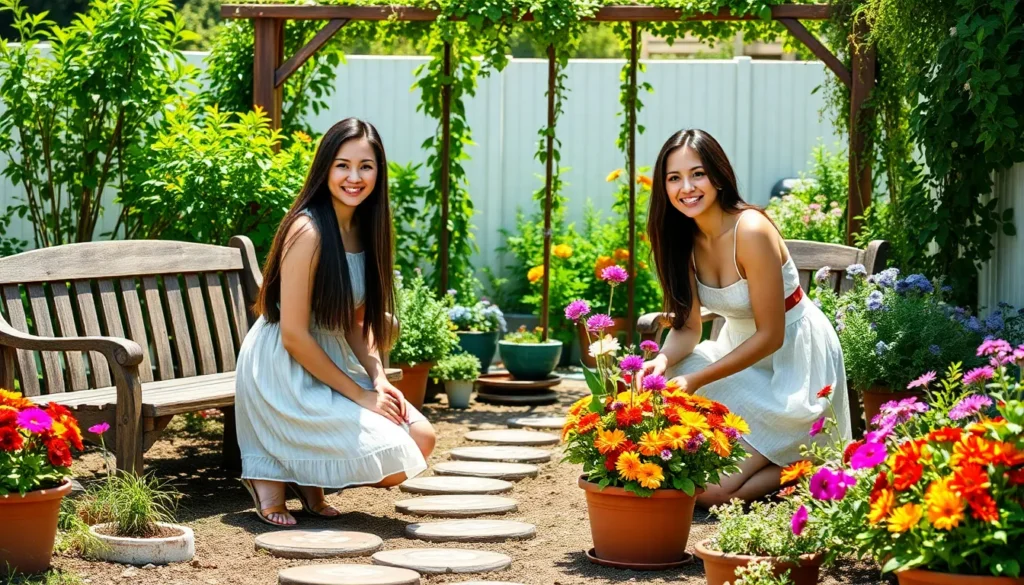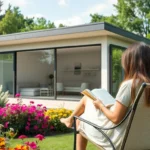Transforming your outdoor space into a stunning garden paradise doesn’t require a professional landscaper or endless budget. We’ve all walked past those picture-perfect gardens that make us stop and stare wondering how we can achieve that same magic in our own backyard.
Whether you’re working with a sprawling lawn or a cozy balcony garden we believe every space has incredible potential waiting to be unlocked. The secret lies in understanding how simple decorative elements can completely transform your garden’s personality and create an outdoor sanctuary you’ll never want to leave.
From budget-friendly DIY projects to strategic plant placement and creative lighting answers we’re about to share game-changing ideas that’ll turn your garden into the neighborhood’s crown jewel. These aren’t just decorating tips – they’re proven strategies that’ll help you create an outdoor space that reflects your style while boosting your home’s curb appeal.
Create Eye-Catching Garden Entrances and Pathways
We’ll transform your garden’s first impression by designing stunning entrances and walkways that guide visitors through your outdoor space with style and purpose.
Design Welcoming Garden Gates
Wooden gates establish a warm, rustic entrance that complements most garden styles and architectural elements. We recommend cedar or redwood materials for their natural weather resistance and beautiful aging properties. Choose between classic picket designs, contemporary horizontal slats, or ornate lattice patterns that match your home’s exterior.
Metal gates offer durability and sophisticated appeal through wrought iron, aluminum, or steel construction options. Install decorative hardware like antique hinges, thumb latches, or electronic keypads for both function and visual interest. Paint these gates in bold colors such as deep navy, forest green, or classic black to create striking focal points.
Living gates incorporate climbing plants, hedges, or bamboo screens that grow into natural barriers over time. Plant fast growing vines like clematis, honeysuckle, or climbing roses along trellises or arbor structures. These organic entrances provide privacy while creating enchanting passageways that change with the seasons.
Install Decorative Stepping Stones
Natural stone pavers create timeless pathways using flagstone, slate, or bluestone materials that blend seamlessly with garden landscapes. Space these stones 18 to 24 inches apart for comfortable walking while allowing grass or ground cover to grow between them. Select irregular shapes for organic appeal or uniform rectangles for modern garden designs.
Concrete stepping stones offer budget friendly alternatives that we can customize with embedded decorative elements like glass marbles, shells, or pressed leaves. Create DIY versions using molds and concrete mix, adding pigments for color variation or stamps for textural patterns. These versatile stones work well in both formal and casual garden settings.
Mosaic stepping stones transform ordinary pathways into artistic expressions through colorful tile, broken pottery, or pebble arrangements. Design custom patterns that reflect your personal style, from geometric shapes to nature inspired motifs like flowers or butterflies. Seal finished stones with grout and weatherproof sealant for long lasting beauty.
Add Curved Walkways with Natural Materials
Gravel pathways provide excellent drainage while creating soft, meandering routes through garden beds and industry features. Choose from pea gravel, crushed granite, or river rock in various sizes and colors to complement your garden’s existing elements. Install edging materials like metal strips or stone borders to maintain clean lines and prevent spreading.
Wood chip trails offer sustainable, low cost answers that suppress weeds naturally while adding organic texture to garden pathways. Source locally available materials like cedar chips, bark mulch, or recycled wood products that decompose slowly and enrich soil over time. Refresh these pathways annually to maintain their appearance and functionality.
Brick and stone combinations create sophisticated curved walkways that incorporate multiple textures and colors for visual interest. Arrange bricks in herringbone, basket weave, or running bond patterns alongside natural stone accents. Use sand base installation for proper drainage and stability, ensuring your walkways remain level and attractive for years to come.
Incorporate Vertical Garden Elements for Maximum Impact
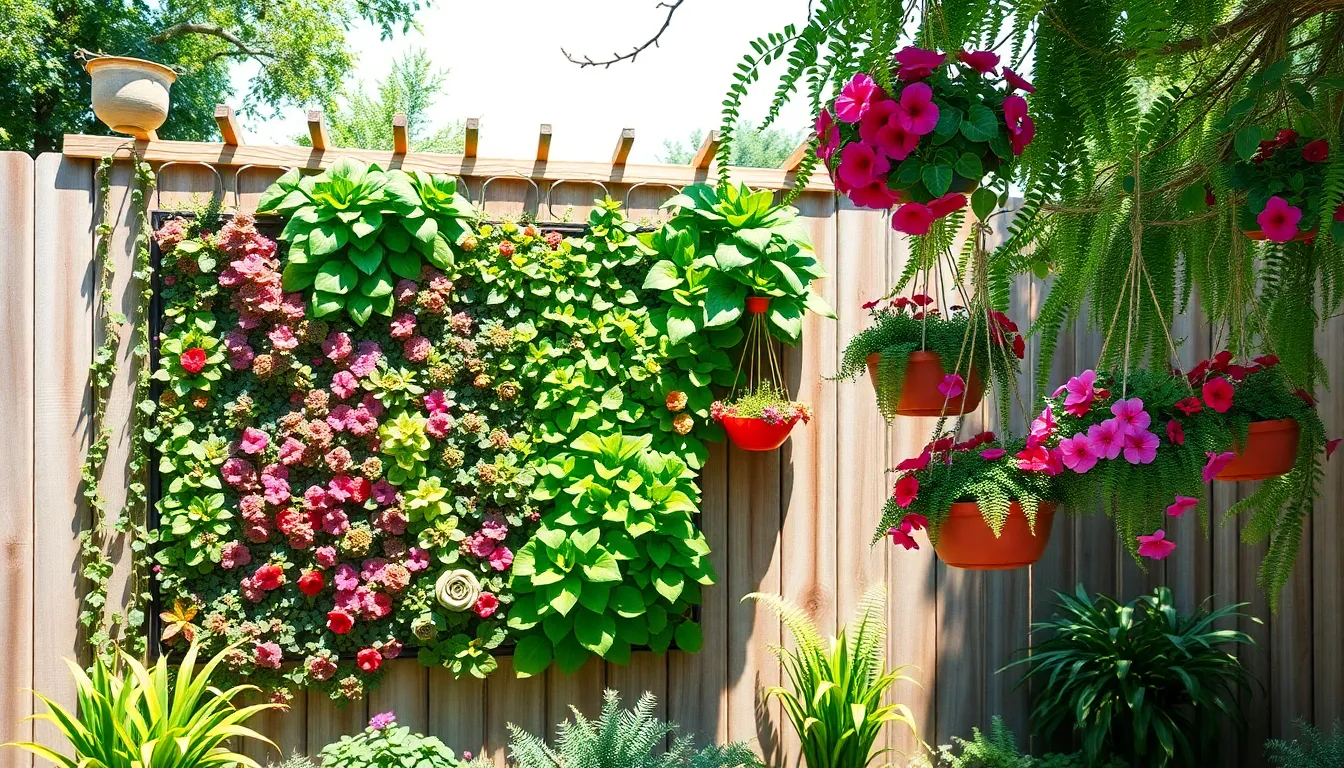
Vertical gardening transforms small outdoor spaces into lush, productive areas that maximize every square inch. We’ll explore three effective ways to add height and visual interest to your garden while creating functional growing spaces.
Build Living Walls with Climbing Plants
Living walls create stunning focal points while serving practical purposes in our gardens. We can bolt panels onto existing retaining walls and plant them with succulents or perennials to enhance functional spaces with natural beauty. Climbing vines offer another excellent option for covering unsightly walls or fences while providing privacy and visual interest.
Grapes and cucumbers thrive when grown vertically against walls, making them perfect choices for edible living walls. Espaliers allow us to train trees or shrubs against walls, creating natural screens that define garden rooms or establish property lines. These structured plantings add architectural interest while maximizing growing space in compact areas.
Install Trellises and Garden Arbors
Trellises provide essential support for climbing plants while adding decorative elements to our gardens. We can install them for vegetables like green beans or melons, combining functionality with visual appeal. These structures work particularly well when placed against walls or used as freestanding features to divide garden spaces.
Garden arbors create inviting entrances and shaded pathways when covered with vines or climbing flowers. They serve as natural gateways between different garden areas while supporting plant growth. We can position arbors over walkways to create tunnel effects or use them as standalone features to anchor seating areas.
Create Hanging Garden Displays
Hanging baskets filled with colorful plants like petunias or lush ferns add texture and color to outdoor spaces at eye level. We can suspend them from pergolas, tree branches, or specially installed hooks to create layered garden displays. These elevated plantings draw the eye upward and make small spaces feel larger.
Macrame hangers offer a unique way to display plants while adding decorative and whimsical touches to our gardens. They work especially well for showcasing trailing plants or small potted specimens. We can group multiple macrame hangers at varying heights to create ever-changing visual compositions that complement our overall garden design.
Add Water Features for Tranquil Garden Ambiance

Water features transform our garden spaces into peaceful retreats that engage multiple senses. These elements create soothing sounds while attracting wildlife and establishing stunning focal points.
Install Small Fountains or Birdbaths
Freestanding fountains serve as perfect centerpieces for patios and garden corners. We can position tiered fountains near seating areas to maximize their visual appeal and calming sound effects. Wall-mounted fountains work exceptionally well in smaller spaces where floor space is limited.
Birdbaths attract local wildlife while creating peaceful ambiance throughout our outdoor spaces. Stand-alone birdbaths fit beautifully among flower beds or along garden pathways. Integrated birdbath designs combine with larger water features to create layered visual interest.
Installation tips include choosing locations away from overhanging branches that drop debris. We should position these features where we can enjoy them from indoor viewing areas like kitchen windows or living rooms.
Create Natural Pond Areas
Koi ponds establish dramatic focal points that support aquatic life and colorful fish displays. We can design these water gardens with varying depths to accommodate different fish species and seasonal changes. Natural stone borders blend seamlessly with surrounding industry elements.
Small water gardens incorporate aquatic plants like water lilies, cattails, and floating hyacinths. These plants help maintain water quality while creating habitat for beneficial insects and amphibians. We should include submerged plants that oxygenate the water naturally.
Pond placement requires consideration of sunlight exposure and proximity to electrical sources for pumps and filtration. Areas receiving 4-6 hours of daily sunlight support healthy plant growth without encouraging excessive algae.
Design Flowing Stream Elements
Natural stone streams connect multiple water features while creating movement and sound throughout our gardens. We can use river rocks, fieldstone, and boulders to create authentic-looking waterways that blend with existing landscaping. These streams flow into ponds or fountains as destination points.
Plant integration softens hard stone edges with ferns, hostas, and ornamental grasses along stream banks. Japanese-inspired designs incorporate acers and stone bowl features called tsukubai for serene meditation spaces. Boulder water features combined with river rocks create unique tranquil environments.
Installation considerations include proper slope calculation for consistent water flow and hidden pump placement. We should design these features with recirculating systems that conserve water while maintaining continuous movement.
Use Outdoor Lighting to Transform Evening Garden Spaces

Strategic lighting transforms our garden spaces into enchanting evening retreats. We can create magical atmospheres while extending the usable hours of our outdoor sanctuaries.
Install Solar-Powered Garden Lights
Solar-powered garden lights offer energy-efficient answers that eliminate wiring complexities. We can strategically place these environmentally friendly fixtures along pathways to guide visitors safely through our garden spaces. Highlighting exact garden features becomes effortless when we position solar lights near prized plantings, sculptures, or architectural elements.
Post lights work exceptionally well for pathway illumination, creating defined walkways that enhance both safety and visual appeal. We’ll discover that solar technology provides consistent evening lighting without increasing our electricity bills. Globe-style solar fixtures create modern organic feels with their moon-like glow, perfectly complementing contemporary garden designs.
Add String Lights for Cozy Atmosphere
String lights create intimate, magical settings that transform ordinary outdoor spaces into cozy gathering areas. We can wrap these versatile lights around trees, deck railings, or trellises to achieve enchanting effects throughout our garden. Pool areas become particularly stunning when string lights reflect off water surfaces, creating beautiful nighttime settings.
Layered lighting approaches work best when we combine string lights with other fixtures like lanterns or spotlights. We’ll find that conversation areas around fire pits benefit tremendously from the warm ambiance that string lights provide. Installing string lights requires minimal effort while delivering maximum visual impact for our evening garden experiences.
Create Dramatic Uplighting Effects
Dramatic uplighting effects highlight our garden’s most impressive features using strategically placed spotlights. We can create stunning focal points by positioning lights at the base of specimen trees, architectural elements, or large plantings. Evening gardens gain sophisticated depth when we use uplighting to emphasize textures and forms that daylight often obscures.
Combining uplighting with other lighting sources creates layered effects that enhance our garden’s overall ambiance. We’ll achieve professional-looking results by experimenting with different angles and intensities to find the perfect balance. Small front yards particularly benefit from uplighting techniques that elevate home curb appeal and create impressive nighttime presentations.
Design Functional Seating Areas Throughout Your Garden
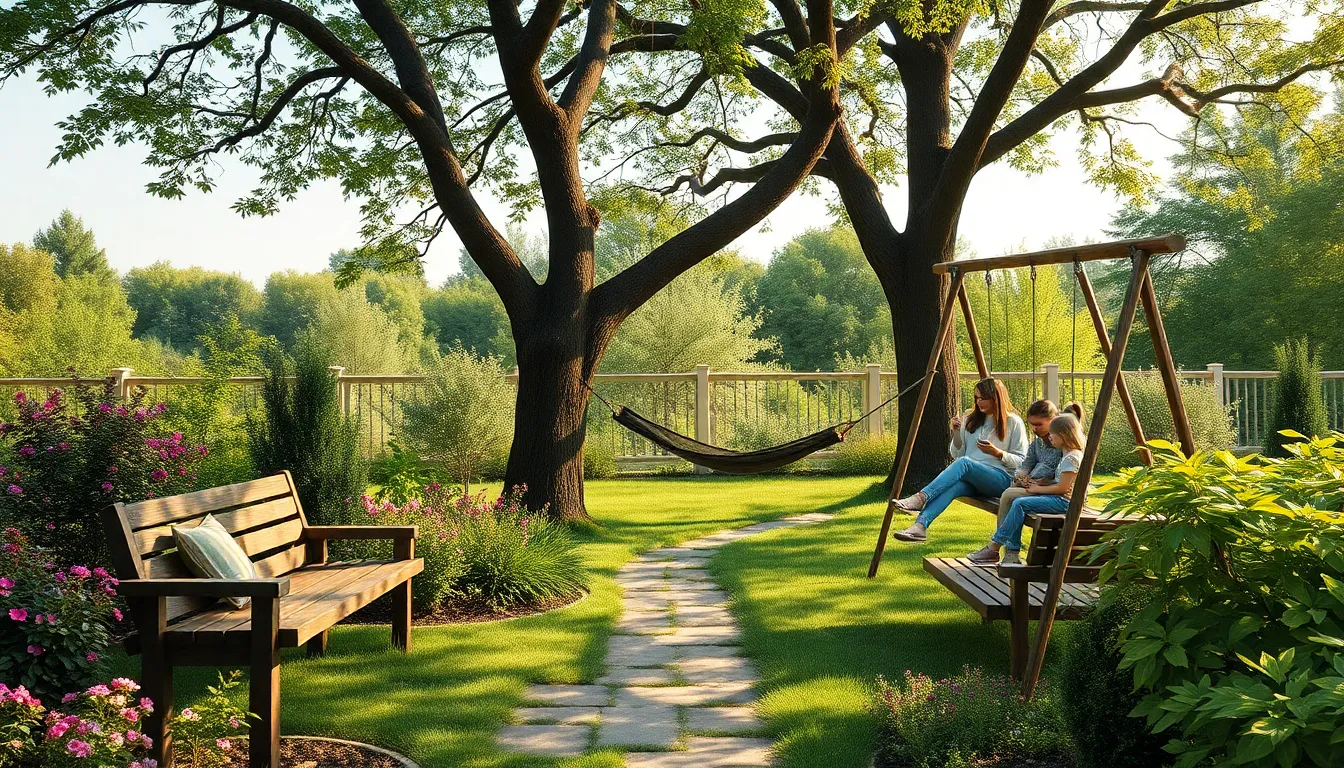
Creating comfortable seating throughout our garden transforms outdoor spaces into inviting retreats where we can relax and connect with nature.
Build Rustic Garden Benches
Natural materials create the perfect foundation for building rustic garden benches that seamlessly blend with our outdoor environment. Wood and stone offer excellent durability while maintaining an organic aesthetic that complements surrounding plantings. We can construct these benches using reclaimed timber or locally sourced stone to achieve an authentic rustic appearance.
Positioning becomes crucial when we’re deciding where to place our handcrafted benches throughout the garden space. Under mature trees provides natural shade and creates serene spots for afternoon relaxation. Near water features allows us to enjoy the soothing sounds of flowing water while we rest.
Built-in seating answers maximize space efficiency by integrating benches directly into retaining walls or raised garden beds. This approach saves valuable square footage while adding functional style to our landscaping design.
Create Cozy Reading Nooks
Seclusion transforms ordinary garden corners into private sanctuaries perfect for reading or quiet meditation. We can use strategically placed plants or decorative trellises to create intimate spaces that feel separate from the main garden areas. Tall grasses and flowering shrubs work exceptionally well as natural privacy screens.
Comfort determines whether our reading nook becomes a frequently used retreat or simply decorative garden furniture. Cushioned chairs provide excellent support for extended reading sessions, while weather-resistant fabrics ensure our seating withstands outdoor conditions. Hammocks offer another comfortable option that adds gentle movement to our relaxation experience.
Weather protection extends the usability of our reading spaces throughout different seasons. Pergolas or garden umbrellas shield us from intense sun and light rain, making our nooks functional year-round gathering spots.
Install Swing Sets or Hammocks
Swing sets bring playful energy to family gardens while providing entertainment for children of all ages. We can choose from traditional wooden swing sets that match our garden’s rustic aesthetic or modern metal designs that offer contemporary appeal. Safety considerations include proper ground clearance and secure anchoring to prevent accidents during use.
Hammocks create instant relaxation zones that require minimal installation effort and space commitment. Hanging them between existing trees provides the most natural setup, though we can also install hammock posts for gardens without suitable tree placement. Brazilian-style hammocks accommodate multiple people, while single hammocks offer personal retreat spaces.
Multiple seating options throughout our garden accommodate different activities and group sizes simultaneously. Dining areas with table seating support outdoor meals, while lounge chairs create spaces for individual relaxation. Social hubs with circular seating arrangements encourage conversation and gatherings among family and friends.
Incorporate Artistic Garden Sculptures and Decorative Objects
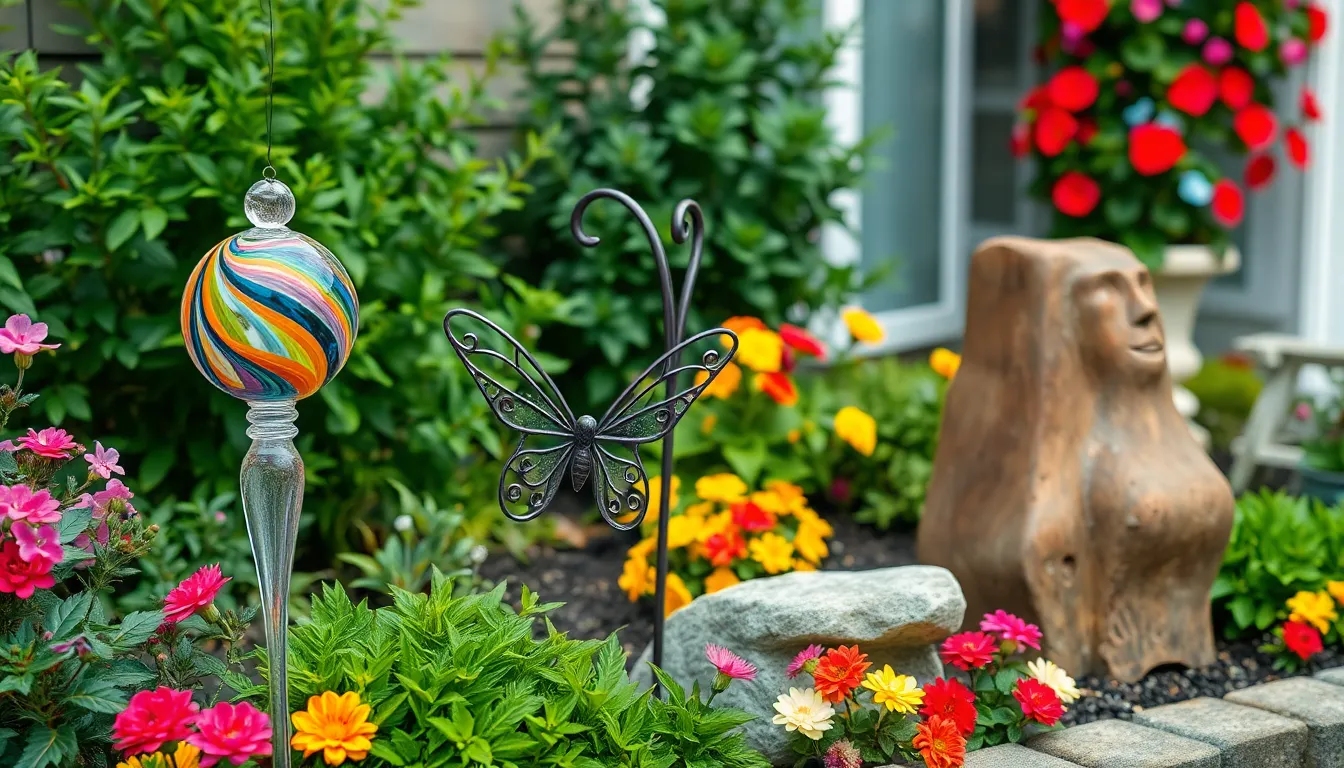
Garden sculptures and decorative objects transform outdoor spaces into personalized artistic showcases. We can elevate our garden’s visual appeal by strategically placing various art pieces throughout different zones.
Add Weather-Resistant Garden Statues
Metal and concrete statues provide lasting beauty in all weather conditions. These materials withstand rain, snow, and intense sun without deteriorating or requiring frequent maintenance. We find that metal sculptures like butterfly or peacock statues add modern touches while maintaining durability throughout seasons.
Stone accent pieces create focal points that improve with age and weathering. Natural stone statues develop attractive patinas over time, improving their character and blending seamlessly with industry elements. Cast stone statuary offers classical or whimsical designs that maintain their elegance year after year.
Handcrafted garden statues in metal or stone materials elevate outdoor spaces with unique artistic flair. These pieces serve as conversation starters and reflect our personal style while requiring minimal upkeep. We recommend positioning larger statues as anchor points in garden beds or along pathways.
Display Colorful Garden Ornaments
Hand-blown glass ornaments reflect light beautifully and add vibrant splashes of color throughout garden spaces. These artistic pieces catch sunlight during the day and can be illuminated at night for extended visual impact. We suggest clustering smaller glass pieces together or using larger statement pieces as standalone features.
Wind bells and chimes create symphony sounds while adding colorful finishes to garden areas. Various metal finishes like copper, bronze, and painted options provide both auditory and visual elements. These hanging ornaments work particularly well near seating areas where we can enjoy their gentle melodies.
Colorful ceramic and pottery pieces introduce artistic elements that complement plantings and seasonal changes. Garden pottery in bright blues, reds, and earth tones creates striking contrasts against green foliage. We can group different sized pieces together for greater visual impact.
Create DIY Art Installations
Wire and steel sculptures offer budget-friendly options for unique garden art that suits both formal and natural settings. Galvanized materials prevent rust while allowing us to create custom shapes and designs. These installations can serve as plant supports or standalone artistic statements.
Functional art pieces combine beauty with practicality in garden settings. Kinetic mobiles add movement and visual interest while artistic scarecrows protect vegetable gardens with style. We can incorporate recycled materials like old garden tools or metal objects to create personalized installations.
Custom mosaic projects transform ordinary surfaces into colorful artistic features. Garden stepping stones, planter edges, and wall sections become canvases for creative expression using broken tiles, glass, and ceramic pieces. These projects allow us to incorporate meaningful colors and patterns that reflect our garden’s overall theme.
Plant Strategic Color Combinations for Visual Appeal
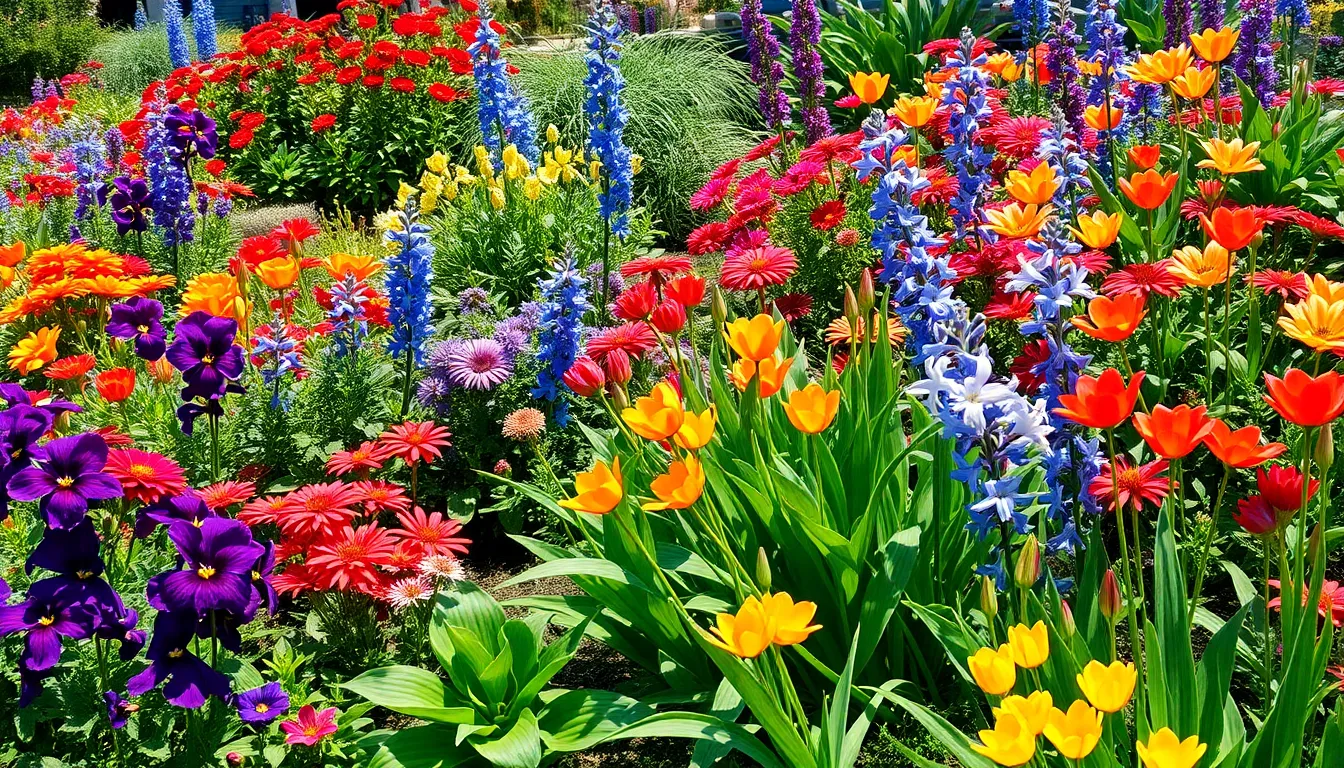
Color choices create the foundation for stunning garden displays that captivate viewers throughout the seasons. We’ll explore strategic approaches to maximize visual impact through thoughtful plant selection and arrangement.
Design Seasonal Flower Arrangements
Monochromatic themes deliver sophisticated elegance by combining different shades of a single color family. We recommend using deep purple pansies with lavender sweet alyssum and pale violet petunias for spring displays. Summer arrangements benefit from coral zinnias paired with salmon geraniums and soft peach marigolds.
Complementary color pairings create vibrant contrasts that energize garden spaces. Blue delphiniums partnered with orange marigolds produce striking visual drama along garden borders. Purple asters combined with yellow coreopsis offer late season interest that extends garden beauty into fall months.
Analogous color schemes provide harmonious transitions between garden sections. Yellow sunflowers, orange nasturtiums, and red salvia create warm progressions perfect for sunny garden areas. Blue lobelia, purple verbena, and pink impatiens establish cool palettes ideal for shadier locations.
Create Contrast with Foliage Plants
Textural variety adds depth through different leaf shapes and sizes that complement seasonal flowers. Large hosta leaves create bold backdrops for delicate astilbe blooms. Fine textured ornamental grasses like fountain grass provide movement alongside sturdy dahlia flowers.
Color combinations between foliage and flowers enhance overall garden appeal. Silver dusty miller leaves make pink petunias appear more vibrant. Deep burgundy coleus foliage intensifies yellow marigold blooms while providing season long interest.
Strategic placement of foliage plants extends visual interest beyond flowering periods. We position chartreuse heuchera near pathways to brighten shaded areas year round. Variegated hostas serve as anchor plants that remain attractive even when companion flowers fade.
Plan Succession Planting Schemes
Layered planting ensures continuous color by combining early, mid, and late season bloomers in the same garden beds. Spring tulips give way to summer daylilies followed by fall asters in carefully planned sequences. We plant crocus bulbs beneath deciduous perennials that emerge later to maximize ground coverage.
Mixed annual and perennial combinations provide both reliability and seasonal variety. Zinnia annuals fill gaps between established coneflower perennials during peak summer months. Cosmos and cleome annuals extend bloom time in perennial borders while attracting beneficial pollinators.
Seasonal transition planning maintains garden interest throughout changing weather patterns. We incorporate ornamental kale and winter pansies for cold weather color after summer annuals fade. Spring bulb plantings begin the cycle anew while perennials remain dormant underground.
Build Raised Garden Beds for Structure and Organization
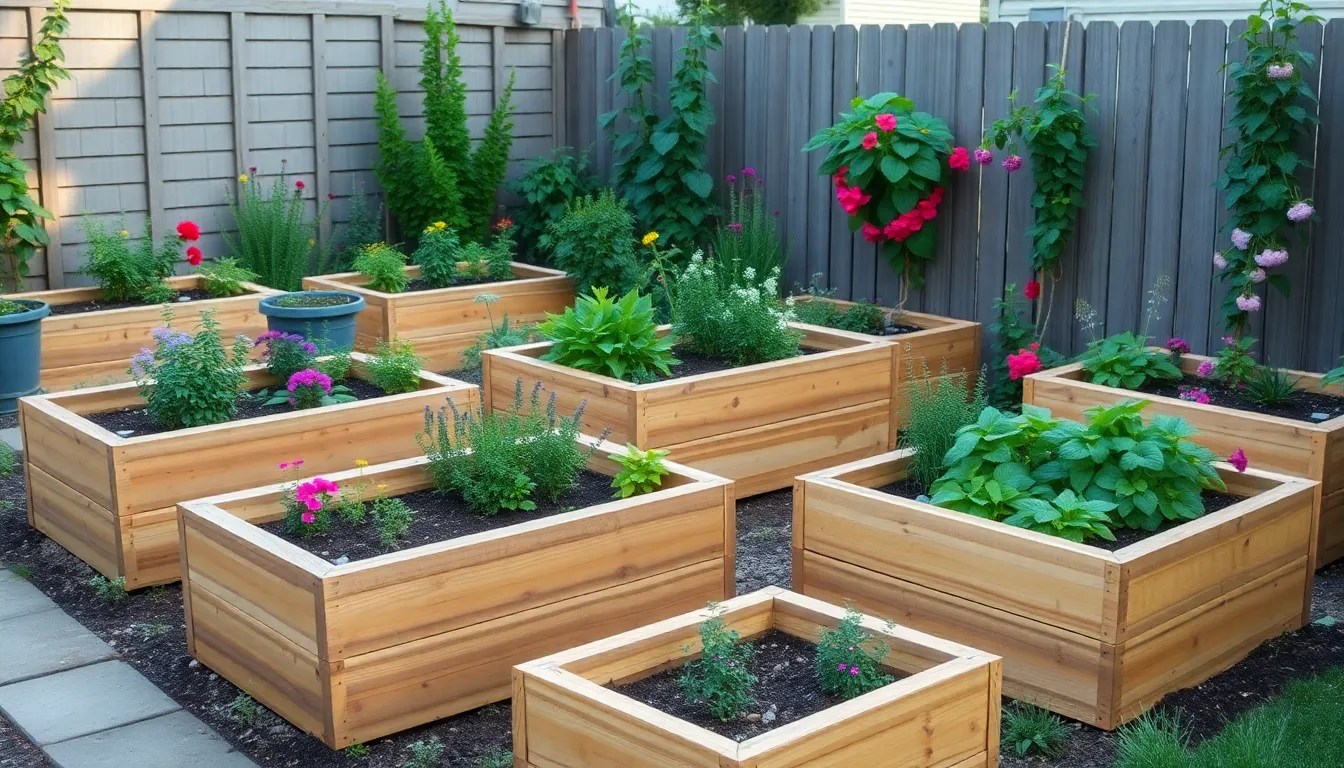
Raised garden beds transform any outdoor space into an organized growing area that’s both functional and visually appealing. These structured planting answers provide clear boundaries while maximizing space efficiency in gardens of all sizes.
Construct Geometric Planting Areas
Geometric raised beds create striking visual patterns that bring modern sophistication to traditional garden spaces. We recommend using square, rectangular, or hexagonal shapes to establish clean lines that complement your home’s architecture. Building these structured areas with matching materials like cedar planks or concrete blocks ensures visual consistency throughout the garden.
Planning geometric layouts requires measuring your available space and sketching different configurations before construction begins. We suggest creating beds that are 3-4 feet wide to allow easy access from all sides without stepping on planted areas. Adding vertical supports within geometric beds accommodates vining plants like tomatoes, beans, and climbing flowers while maintaining the structured aesthetic.
Design Tiered Garden Levels
Tiered raised beds add dimensional depth that transforms flat outdoor spaces into ever-changing growing environments. We build these multilevel systems using retaining walls or stepped wooden frames that create natural terraces for different plant heights. This vertical approach maximizes growing space while improving drainage flow from upper to lower levels.
Constructing tiered gardens involves placing taller beds in back areas and gradually decreasing heights toward front spaces for optimal sunlight exposure. We recommend installing proper drainage systems between levels to prevent water accumulation and root rot issues. These stepped designs work particularly well on sloped terrain where natural elevation changes already exist.
Create Separate Themed Garden Zones
Themed garden zones within raised bed systems allow us to organize plants by purpose, growing requirements, or aesthetic appeal. We design dedicated areas for herb gardens, butterfly attracting flowers, sensory plants, or seasonal displays that serve exact functions. Each themed zone can feature unique decorative elements, plant selections, and maintenance schedules.
Building themed zones requires selecting appropriate bed sizes based on plant mature sizes and spacing requirements. We line raised beds with industry fabric or hardware cloth to prevent pest infiltration and maintain soil quality over time. Installing efficient drip irrigation systems in each themed area ensures optimal water distribution while reducing maintenance demands across different plant groups.
Add Natural Elements Like Rocks and Driftwood
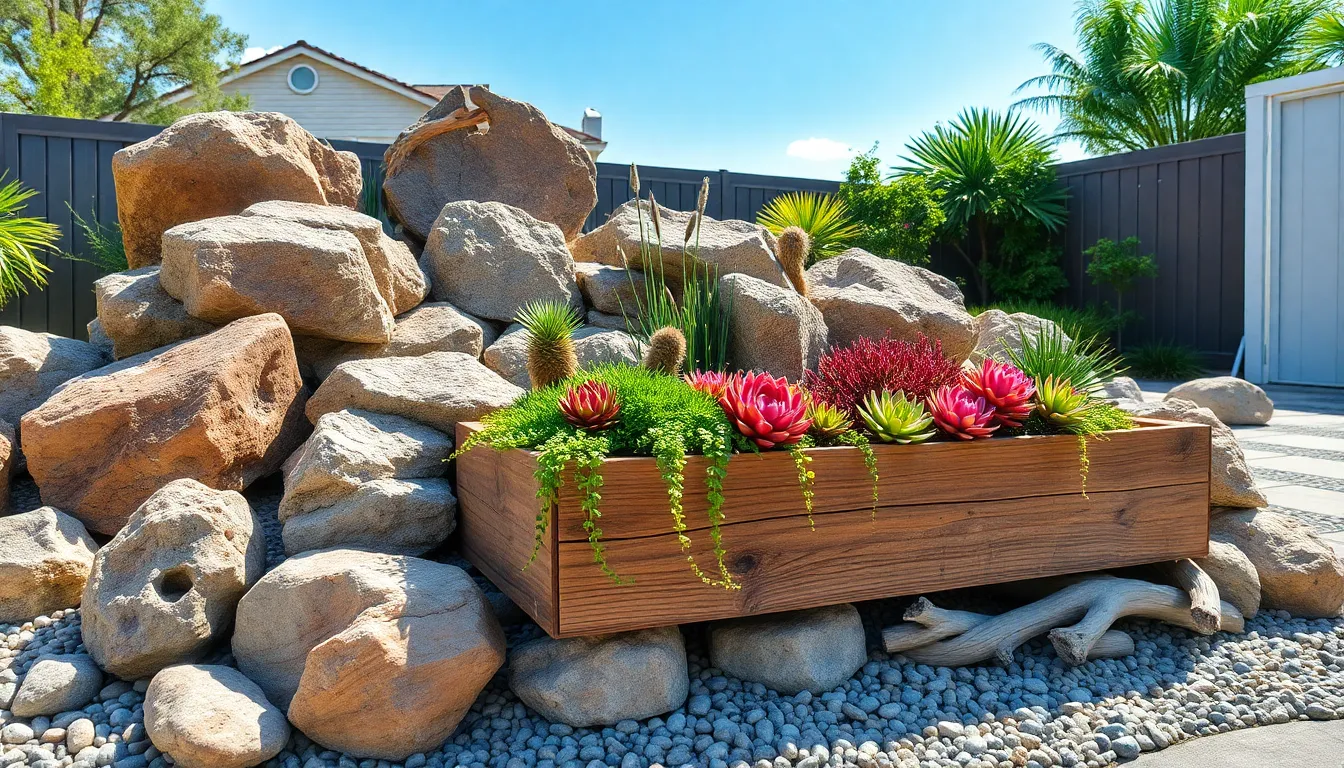
Natural materials transform ordinary garden spaces into stunning outdoor sanctuaries that reflect the beauty of untouched landscapes. These organic elements create visual harmony while requiring minimal maintenance throughout the seasons.
Incorporate Boulder Arrangements
Boulder placement creates dramatic focal points that anchor different garden areas with permanent structural appeal. We recommend positioning larger stones near seating areas or water features to establish natural gathering spaces. Strategic groupings of three to five boulders work best for creating visual balance without overwhelming smaller garden sections. Varying the heights and angles of your boulder arrangements adds dimensional depth that draws the eye naturally through the industry.
Complementary plantings around boulder groupings soften harsh edges while maintaining the rugged aesthetic. Native grasses like fountain grass or ornamental sedums work exceptionally well between rock formations. These combinations require less water than traditional flower beds while providing year round interest. Pathways can wind around boulder clusters to create intimate garden rooms that feel secluded yet connected.
Design Rock Gardens with Succulents
Succulent plantings among rocks create low maintenance garden features that thrive in well draining environments throughout various climate conditions. We suggest using rocks of different sizes and colors to establish natural planting pockets that accommodate root systems effectively. Limestone, sandstone, and granite provide excellent drainage while offering distinct aesthetic qualities that complement various succulent varieties.
Plant selection should focus on drought tolerant species like hens and chicks, echeveria, and jade plants that flourish in rocky terrain. These varieties spread naturally over time to fill gaps between stones without requiring frequent replanting. Color coordination between rock tones and succulent foliage creates cohesive displays that look professionally designed. Gravel mulch around plantings prevents weeds while maintaining the natural rock garden appearance.
Use Natural Wood Features
Wooden planters made from reclaimed materials add rustic charm while supporting sustainable gardening practices that benefit both budgets and environments. Cedar and redwood naturally resist decay without chemical treatments, making them ideal choices for long lasting garden installations. We recommend building raised planters that showcase trailing plants or herb gardens near outdoor living spaces. These elevated features create visual interest at multiple height levels throughout the garden.
Decorative wooden elements like driftwood sculptures or log borders define garden sections while maintaining organic aesthetics that blend seamlessly with natural landscapes. Fallen branches can become unique plant supports or artistic installations when positioned thoughtfully among flower beds. Weather resistant finishes protect wooden features from moisture damage while preserving their natural grain patterns. Regular maintenance with natural oils keeps wood elements looking fresh while extending their functional lifespan significantly.
Create Themed Garden Sections for Unique Character

Themed garden sections transform ordinary outdoor spaces into unique destinations that reflect our personal interests and lifestyle preferences. We can develop distinct areas within our gardens to create varied experiences and visual appeal throughout the space.
Design Herb and Kitchen Gardens
Raised bed gardens offer ideal answers for growing herbs and vegetables in small spaces or areas with poor soil conditions. These elevated planting areas provide better drainage and easier maintenance while creating organized sections within our garden design.
Structural elements like trellises and arbors support climbing herbs such as rosemary while adding vertical interest to kitchen garden spaces. We can position these features to create natural divisions between different themed areas.
Functional pathways connect kitchen gardens to our home’s entrance for convenient harvesting during meal preparation. Stone or brick walkways between raised beds prevent soil compaction and maintain clean access routes.
Companion planting arrangements group herbs with vegetables that benefit from shared growing conditions. Basil planted near tomatoes and oregano positioned alongside peppers create both practical and visually appealing combinations.
Build Butterfly or Pollinator Gardens
Diverse plantings incorporating sunflowers, zinnias, and marigolds attract various pollinators throughout the growing season. These colorful additions provide continuous blooms that support local butterfly populations and beneficial insects.
Native plant selections attract regional butterflies and pollinators more effectively than non-native species. We should research indigenous flowering plants that thrive in our exact climate conditions and soil types.
Layered heights create visual depth while providing different perching and feeding opportunities for pollinators. Tall sunflowers serve as backdrops while medium-height zinnias fill middle spaces and low-growing marigolds edge garden borders.
Water sources like shallow dishes or small birdbaths provide essential hydration for visiting butterflies and bees. These features become focal points while supporting the overall health of our pollinator garden network.
Create Zen or Meditation Spaces
Green walls installed as vertical gardens create peaceful backdrops for meditation areas while maximizing limited space. These living installations filter air and provide natural sound barriers from surrounding activities.
Water features including small fountains or birdbaths generate soothing sounds that enhance meditation experiences. We can position these elements where their gentle sounds mask neighborhood noise while creating focal points for contemplation.
Seating areas designed with natural materials like stone or wood blend harmoniously with surrounding plantings. Weathered wood benches or smooth stone seating provide comfortable spots for quiet reflection and mindfulness practices.
Fragrant plantings featuring lavender, rosemary, and nicotiana engage multiple senses during meditation sessions. These aromatic additions create immersive experiences that deepen our connection with the natural environment.
Conclusion
Creating your dream garden doesn’t require professional expertise or endless resources. With these decorating ideas we’ve shared you can transform any outdoor space into a personal sanctuary that reflects your unique style and enhances your home’s appeal.
Remember that the most successful gardens combine multiple elements harmoniously. Whether you’re adding water features lighting sculptural elements or creating themed sections the key lies in thoughtful planning and gradual implementation.
Start with one or two projects that excite you most then build upon your successes. Your garden will evolve naturally over time becoming a space where you’ll love spending hours whether you’re entertaining guests or simply enjoying quiet moments surrounded by beauty you’ve created yourself.
Frequently Asked Questions
Can I create a beautiful garden without hiring a professional landscaper?
Absolutely! You can transform any outdoor space into a stunning garden using simple decorative elements, strategic plant placement, and creative lighting. The key is focusing on budget-friendly DIY projects that reflect your personal style while enhancing your home’s curb appeal.
What are some budget-friendly ways to enhance my garden entrance?
Create welcoming garden gates using cedar, redwood, or metal materials. Install decorative stepping stones like natural stone pavers or mosaic designs. Consider curved walkways made from gravel, wood chips, or brick combinations for both aesthetic appeal and functional drainage.
How can I maximize impact in small outdoor spaces?
Incorporate vertical garden elements like living walls with climbing plants, trellises, and garden arbors. Use hanging garden displays with baskets and macrame hangers to add texture and color at eye level, making small spaces feel larger and more dynamic.
What water features work best for creating a tranquil garden atmosphere?
Small fountains and birdbaths serve as excellent focal points while attracting wildlife. Natural pond areas with aquatic plants help maintain water quality and support ecosystems. Flowing stream elements can connect various water features, enhancing movement and soothing sounds throughout your garden.
How can outdoor lighting transform my evening garden experience?
Use solar-powered garden lights for energy-efficient pathway illumination. String lights wrapped around trees create cozy gathering atmospheres. Dramatic uplighting techniques highlight key garden features, adding depth and sophistication to your evening outdoor spaces.
What are the best materials for building garden seating areas?
Natural materials like wood and stone create durable, rustic garden benches with organic aesthetics. Position seating under mature trees or near water features for optimal relaxation. Consider built-in seating options for space efficiency and swing sets or hammocks for playful alternatives.
How do I choose the right garden sculptures and decorative objects?
Select weather-resistant statues made from metal and concrete for lasting beauty with minimal maintenance. Add colorful ornaments like hand-blown glass pieces and ceramic pottery for vibrancy. Consider DIY art installations including wire sculptures and custom mosaics for budget-friendly personalization.
What’s the best approach to using color in plant selection?
Use monochromatic themes, complementary color pairings, or analogous color schemes for visual appeal. Incorporate foliage plants for texture and plan succession planting with early, mid, and late-season flowers. Combine annuals and perennials to maintain vibrant displays year-round.
How do I create themed garden sections effectively?
Design herb and kitchen gardens with raised beds for better drainage and maintenance. Create butterfly gardens using diverse native plantings to attract beneficial insects. Establish Zen spaces with green walls, soothing water features, and fragrant plantings for meditation and mindfulness experiences.
What are the benefits of raised beds in garden design?
Raised beds provide better drainage, easier maintenance, and improved soil control. They create visual structure in your garden while making planting and harvesting more accessible. Raised beds also allow for better organization of themed sections and companion planting strategies.

